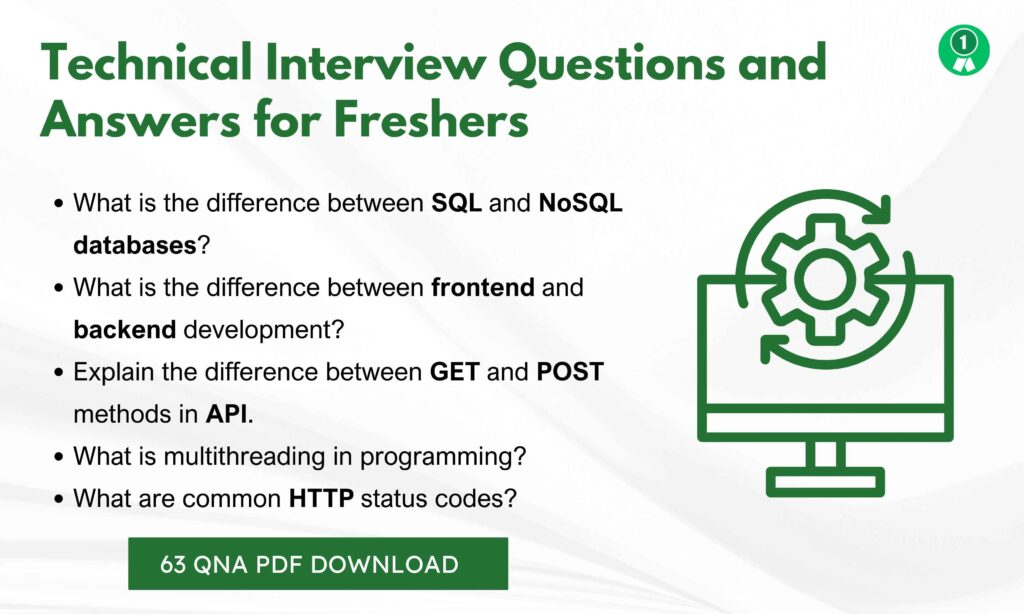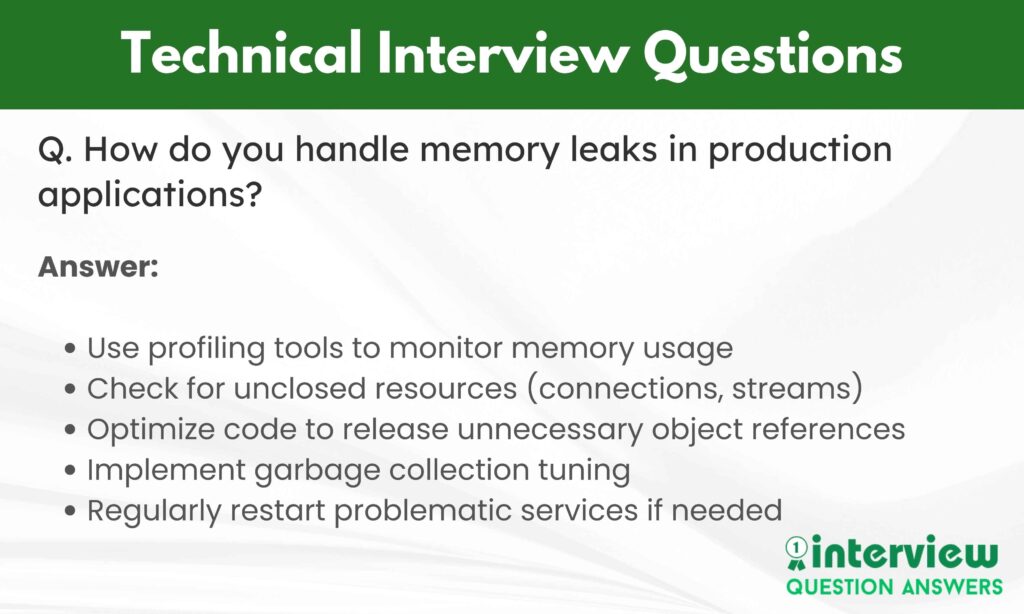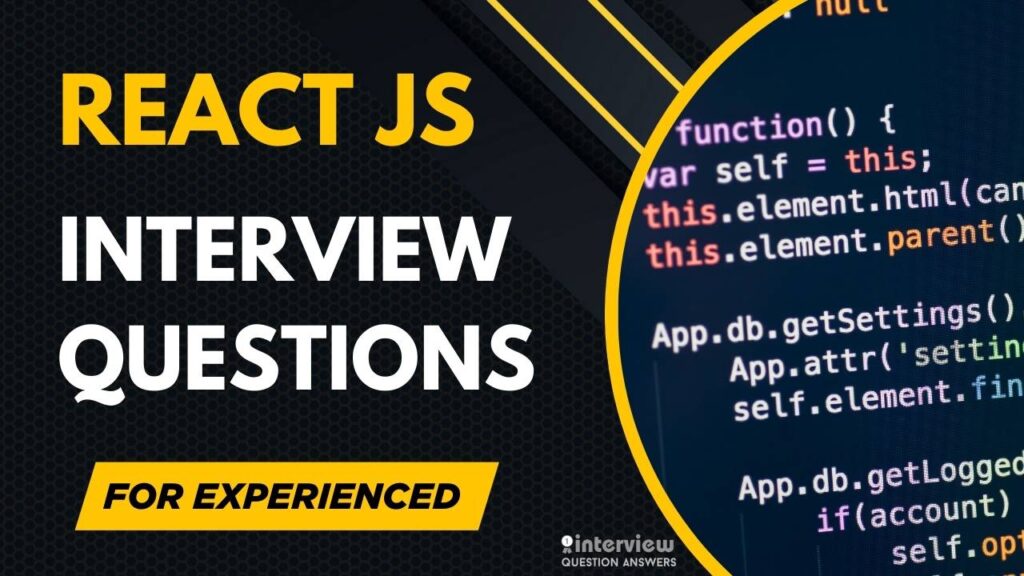Technical roles are jobs where people work with technology to build, maintain, or improve systems, software, and products. These roles are important in almost every industry today. These roles often involve working with complex data, analyzing information, and using various software to solve problems.
Individuals in technical positions, possess proficiency in data analysis, data visualization, and programming languages like Python. They are well-versed in handling complex data sets, data cleaning, and ensuring data integrity while analyzing large amounts of data to derive meaningful insights.
Preparing for a technical interview is crucial as it helps candidates demonstrate their knowledge and skills, making them stand out to potential employers.
Here, we are sharing a comprehensive collection of popular interview questions and answers tailored for both freshers and experienced candidates, covering essential topics such as data profiling, exploratory data analysis, and data validation. Additionally, we will provide a PDF download to facilitate offline preparation, ensuring you are well-equipped for your next data analyst interview.
Table of Contents
Technical Interview Questions
We are sharing guides with interview questions and answers for various technical roles to help you prepare for your desired job.
Technical Interview Questions and Answers for Freshers
Que 1. What is the difference between static and dynamic IP addresses?
Answer:
From a networking perspective, could you explain the difference between static and dynamic IP addresses, and why a company might choose one over the other for certain devices?
Que 2. What is the difference between a compiler and an interpreter?
Answer:
- Compiler: Converts the entire program into machine code before execution. Example: C, C++.
- Interpreter: Converts code into machine code line-by-line during execution. Example: Python, JavaScript.
Que 3. What is network segmentation, and how can it improve company security?
Answer:
- In larger company networks, segmentation is often used. Can you explain what network segmentation is and how it can help contain security breaches and improve overall network performance.
Que 4. What is a database?
Answer:
A database is an organized collection of data stored electronically that allows easy access, management, and updating of data.
Que 5. What is the difference between SQL and NoSQL databases?
Answer:
| SQL Databases | NoSQL Databases |
|---|---|
| Structured tables | Unstructured or semi-structured data |
| Use SQL language | Use various query methods |
| Example: MySQL, Oracle | Example: MongoDB, Firebase |
Que 6. What is version control, and why is Git popular?
Answer:
Version control tracks changes to code over time. Git is popular because it allows multiple developers to work on code together efficiently, provides branch management, and tracks history of changes.
Que 7. What is the difference between frontend and backend development?
Answer:
- Frontend Development: Works on the user interface part of a website or application (HTML, CSS, JavaScript).
- Backend Development: Focuses on server-side logic, databases, and APIs (Java, Python, Node.js).
Que 8. What is responsive design?
Answer:
Responsive design ensures that websites or applications adjust their layout and content automatically to look good on all devices like desktops, tablets, and smartphones.
Que 9. What is an API?
Answer:
API (Application Programming Interface) is a set of rules that allows two software systems to communicate with each other. APIs help applications fetch or send data to other services.
Que 10. Explain the difference between GET and POST methods in API.
Answer:
- GET: Requests data from a server (used for retrieving data).
- POST: Sends data to a server to create or update resources (used for submitting data).
Que 11. What is multithreading in programming?
Answer:
Multithreading is a feature that allows a CPU to execute multiple threads (smallest units of process) concurrently, improving the performance of programs that perform many tasks simultaneously.
Que 12. What is exception handling?
Answer:
Exception handling is a method to handle runtime errors in a program using constructs like try, catch, and finally to prevent crashes and handle errors smoothly.
Example in Java:
try {
int result = 10 / 0;
} catch (ArithmeticException e) {
System.out.println("Cannot divide by zero.");
}Que 13. What are joins in SQL?
Answer:
Joins in SQL combine rows from two or more tables based on a related column.
- INNER JOIN: Returns matching rows from both tables.
- LEFT JOIN: Returns all rows from the left table, matching from the right if available.
- RIGHT JOIN: Returns all rows from the right table, matching from the left if available.
- FULL JOIN: Returns all rows when there is a match in either table.
Que 14. What is load balancing?
Answer:
Load balancing distributes network or application traffic across multiple servers to ensure no single server becomes overwhelmed, improving reliability and performance.
Que 15. What are common HTTP status codes?
Answer:
| Status Code | Meaning |
|---|---|
| 200 | OK (Success) |
| 404 | Not Found |
| 500 | Internal Server Error |
| 403 | Forbidden |
| 301 | Moved Permanently |
Que 16. What is cloud computing?
Answer:
Cloud computing provides services like storage, servers, databases, and software over the internet (cloud) instead of using local servers. Examples include AWS, Microsoft Azure, and Google Cloud.
Que 17. What is CI/CD in DevOps?
Answer:
- CI (Continuous Integration): Regularly merging code changes into a shared repository.
- CD (Continuous Deployment/Delivery): Automatically deploying code changes to production after testing.
This process helps release software updates quickly and reliably.
Que 18. What is the difference between symmetric and asymmetric encryption?
Answer:
- Symmetric Encryption: Uses the same key for both encryption and decryption.
- Asymmetric Encryption: Uses a public key for encryption and a private key for decryption.
Que 19. What is DNS?
Answer:
DNS (Domain Name System) converts human-readable domain names (like google.com) into IP addresses that computers use to identify each other on the network.
Que 20. What is a deadlock in operating systems?
Answer:
A deadlock occurs when two or more processes wait indefinitely for resources held by each other, preventing any of them from proceeding. Handling deadlocks is important in systems programming to ensure smooth execution of processes.

Also Check: IT Interview Questions and Answers
Que 21. What is the difference between a process and a thread?
Answer:
A process is an independent program in execution with its own memory space. A thread is a lightweight sub-process that shares memory with other threads within the same process. Threads are used to perform tasks concurrently, while processes are isolated and heavier in terms of system resources.
Que 22. How does a stack differ from a queue in data structures?
Answer:
A stack follows the LIFO (Last In, First Out) principle, meaning the last element added is the first to be removed. A queue uses FIFO (First In, First Out), so the first element added is removed first. Stacks are used in function calls, while queues are used in scheduling and resource management.
Que 23. What is recursion and when would you use it?
Answer:
Recursion is a programming technique where a function calls itself to solve smaller instances of the same problem. It’s commonly used in problems like factorial calculation, tree traversal, and Fibonacci series. Recursion must have a base condition to prevent infinite calls.
Que 24. What is normalization in databases?
Answer:
Normalization is the process of organizing data in a database to reduce redundancy and improve data integrity. It involves dividing large tables into smaller ones and defining relationships between them. Common normal forms include 1NF, 2NF, and 3NF.
Que 25. How does a hash table work?
Answer:
A hash table stores key-value pairs and uses a hash function to compute an index into an array. The data is stored at the computed index. It provides average-case constant time complexity (O(1)) for lookups, insertions, and deletions.
Que 26. What is the role of an operating system?
Answer:
An operating system (OS) manages hardware resources and provides essential services to applications. It handles memory management, process scheduling, file systems, device management, and user interfaces, ensuring smooth system operations.
Que 27. What is the difference between compile-time and run-time errors?
Answer:
- Compile-time errors occur when code violates syntax rules and are detected by the compiler (e.g., missing semicolon).
- Run-time errors occur during program execution (e.g., dividing by zero or null pointer access).
Que 28. What is a firewall and how does it work?
Answer:
A firewall is a network security device or software that monitors and filters incoming and outgoing traffic based on defined rules. It protects systems from unauthorized access, malware, and network-based threats by creating a barrier between trusted and untrusted networks.
Que 29. What is JSON and how is it used?
Answer:
JSON (JavaScript Object Notation) is a lightweight data-interchange format. It is easy for humans to read and write, and for machines to parse. It’s commonly used to exchange data between a server and a web or mobile application.
Que 30. What is latency in computer networks?
Answer:
Latency refers to the time it takes for data to travel from the source to the destination. It includes delays caused by transmission, propagation, processing, and queuing. Low latency is crucial for real-time applications like video conferencing and online gaming.
Que 31. What is unit testing in software development?
Answer:
Unit testing involves testing individual components or functions of software to ensure they work as intended. It’s done during development using frameworks like JUnit (Java), pytest (Python), or NUnit (.NET). Unit tests help detect bugs early and improve code quality.
Que 32. What is a virtual machine?
Answer:
A virtual machine (VM) is an emulated computer system that runs on top of a physical host. It enables multiple OS environments to run independently on the same hardware. VMs are widely used in testing, development, and cloud infrastructure.
Que 33. What is a MAC address?
Answer:
A MAC (Media Access Control) address is a unique identifier assigned to a network interface card (NIC). It operates at the data link layer and is used for communication within a local network. MAC addresses are fixed and hardware-specific.
Que 34. What is the difference between public, private, and protected access in OOP?
Answer:
| Access Modifier | Scope |
|---|---|
| Public | Accessible from any class |
| Private | Accessible only within the same class |
| Protected | Accessible within the class and its subclasses |
These control how class members are accessed and help enforce encapsulation.
Que 35. What is two-factor authentication (2FA)?
Answer:
2FA is a security mechanism that requires two forms of identity verification—typically something the user knows (password) and something the user has (OTP, phone, or biometric). It enhances account security beyond just a password.
Que 36. What is a software development lifecycle (SDLC)?
Answer:
SDLC is a structured approach to software development involving stages such as:
- Requirement gathering
- Design
- Implementation
- Testing
- Deployment
- Maintenance
It ensures a systematic and efficient process to deliver high-quality software.
Que 37. What is the difference between HTTPS and HTTP?
Answer:
- HTTP transmits data in plain text, making it vulnerable to interception.
- HTTPS uses SSL/TLS to encrypt data, ensuring secure communication between client and server.
HTTPS is essential for protecting sensitive information like login credentials and financial data.
Que 38. What are the main principles of Object-Oriented Programming (OOP)?
Answer:
The four core principles are:
- Encapsulation: Bundling data and methods
- Abstraction: Hiding complex details
- Inheritance: Reusing properties and methods
- Polymorphism: Multiple forms of methods/functions
These principles help build scalable and maintainable software.
Que 39. What is a race condition in concurrent programming?
Answer:
A race condition occurs when two or more threads access shared data simultaneously, and the result depends on the sequence of access. It leads to unpredictable behavior or bugs. Synchronization mechanisms like locks or semaphores are used to prevent it.
Que 40. What is the role of API testing in software development?
Answer:
API testing ensures that the backend services of an application work correctly, securely, and efficiently. It involves validating endpoints, response formats, error codes, authentication, and performance. Tools like Postman, Rest Assured, and JMeter are commonly used.
Technical Interview Questions and Answers for Experienced
Que 41. What is system architecture design?
Answer:
System architecture design is the process of planning the structure and interaction of components within a software or IT system. It involves defining components like servers, databases, APIs, user interfaces, and how they communicate, ensuring scalability, security, and reliability.
Que 42. What is the difference between monolithic and microservices architecture?
Answer:
- Monolithic Architecture: All features and components are part of a single application.
- Microservices Architecture: The application is broken into smaller, independent services that communicate via APIs, improving scalability and flexibility.
Que 43. Explain horizontal vs vertical scaling in cloud systems.
Answer:
- Horizontal Scaling: Adding more machines/instances to handle increased load.
- Vertical Scaling: Increasing the resources (CPU, RAM) of a single machine to handle more load.
Que 44. How do you secure APIs in a production environment?
Answer:
- Use authentication and authorization (OAuth, JWT).
- Implement rate limiting to avoid abuse.
- Validate inputs to prevent injection attacks.
- Use HTTPS to encrypt data.
- Apply CORS policies carefully.
Que 45. What is containerization, and why is Docker used?
Answer:
Containerization packages applications and their dependencies together, so they run consistently across environments. Docker is widely used because it simplifies container creation, deployment, and management, reducing environment conflicts.
Que 46. What is Kubernetes, and why is it important?
Answer:
Kubernetes is an open-source platform used for automating deployment, scaling, and managing containerized applications. It ensures efficient resource utilization, load balancing, self-healing, and easy scaling of applications in production environments.
Que 47. What are design patterns in software engineering?
Answer:
Design patterns are reusable solutions to common software design problems. Common examples include Singleton, Factory, Observer, and MVC (Model-View-Controller) patterns.
Que 48. How does caching improve system performance?
Answer:
Caching stores frequently accessed data temporarily to reduce the load on databases or servers. This speeds up data retrieval and enhances the performance of applications by avoiding repeated expensive operations.
Que 49. Explain database indexing and its types.
Answer:
Indexing in databases speeds up query performance by creating data structures that help locate data quickly.
Types of indexing:
- Single-column Index
- Composite Index
- Unique Index
- Full-text Index
- Clustered and Non-clustered Index
Que 50. What is a reverse proxy, and why is it used?
Answer:
A reverse proxy is a server that sits between client requests and backend servers, forwarding client requests to the appropriate servers. It’s used for load balancing, caching, SSL termination, and protecting backend servers from direct exposure.
Que 51. How do you handle concurrency issues in applications?
Answer:
- Using locks (pessimistic or optimistic)
- Implementing transactions
- Applying synchronization mechanisms
- Designing for idempotency
- Using database isolation levels like Read Committed, Repeatable Read
Que 52. What is message queuing, and when is it needed?
Answer:
Message queuing enables asynchronous communication between services using queues. Tools like RabbitMQ or Kafka help manage workloads, ensuring messages are processed reliably even when systems are busy.
Que 53. How does OAuth 2.0 work?
Answer:
OAuth 2.0 is an authorization framework that lets users grant limited access to their resources without sharing credentials. It involves an authorization server issuing access tokens that clients use to access protected APIs securely.
Que 54. What are the types of load testing?
Answer:
- Stress Testing: Determines system limits by pushing beyond normal loads.
- Spike Testing: Tests sudden traffic spikes.
- Soak Testing: Checks system stability over a prolonged period.
- Load Testing: Tests system under expected traffic levels.
Que 55. What is Infrastructure as Code (IaC)?
Answer:
IaC automates infrastructure setup using code scripts rather than manual configurations. Tools like Terraform and AWS CloudFormation help manage servers, networks, and databases as version-controlled code.
Que 56. How do you design a fault-tolerant system?
Answer:
- Redundant servers and components
- Load balancers to distribute traffic
- Failover mechanisms
- Data replication across regions
- Monitoring and automated recovery processes
Que 57. What is Zero Downtime Deployment?
Answer:
It’s a deployment strategy that updates applications without making them unavailable. Techniques include blue-green deployments, canary releases, and using load balancers to redirect traffic smoothly.
Que 58. How do you handle memory leaks in production applications?
Answer:
- Use profiling tools to monitor memory usage
- Check for unclosed resources (connections, streams)
- Optimize code to release unnecessary object references
- Implement garbage collection tuning
- Regularly restart problematic services if needed

Que 59. What is Event-Driven Architecture?
Answer:
An architecture style where services communicate through events instead of direct requests. It improves decoupling and scalability, often implemented using message brokers like Kafka or AWS SNS/SQS.
Que 60. How do you ensure database backup and disaster recovery?
Answer:
- Regular automated backups
- Multi-region replication
- Periodic backup testing
- Storing backups in secure, redundant locations
- Creating disaster recovery plans with defined RTO (Recovery Time Objective) and RPO (Recovery Point Objective) targets
Que 61. How would you design a high-availability, low-latency distributed system?
Answer:
To design such a system, focus on:
- Load balancing using tools like HAProxy or ELB
- Replication for data across regions (e.g., multi-AZ RDS or Cassandra)
- Caching using Redis or CDN for static content
- Failover mechanisms via health checks and auto-scaling groups
- Monitoring with tools like Prometheus and Grafana
Key goals are to eliminate single points of failure, reduce response times, and maintain consistency under load.
Que 62. How do you handle API versioning in production systems?
Answer:
Best practices for API versioning include:
- URI Versioning (e.g.,
/v1/resource) - Header-based versioning using
Acceptheaders - Query parameter versioning (
?version=1)
URI versioning is most common. Keep older versions stable while allowing new features in newer versions to maintain backward compatibility.
Que 63. Explain the CAP theorem and its impact on distributed database design.
Answer:
CAP theorem states that a distributed database system can only guarantee two out of three:
- Consistency: All nodes see the same data
- Availability: System always responds (possibly with stale data)
- Partition tolerance: System continues working despite network issues
Most systems sacrifice consistency (e.g., Cassandra, DynamoDB) for high availability and partition tolerance.
Que 64. How do you ensure scalability in a microservices-based architecture?
Answer:
Scalability can be achieved by:
- Containerization (Docker + Kubernetes)
- Service discovery using tools like Consul or Eureka
- Horizontal scaling of stateless services
- Asynchronous communication via message queues (Kafka, RabbitMQ)
- Load testing and autoscaling configurations
Each service should be independently deployable and scalable.
Que 65. How do you prevent memory leaks in long-running applications?
Answer:
To prevent memory leaks:
- Avoid global variables and static references holding objects
- Use weak references (
WeakReferencein Java) - Regularly profile memory (using
jvisualvm,valgrind, etc.) - Close file/database connections and unsubscribe from listeners
- Use garbage collection-friendly data structures
Consistent code review and monitoring are key for early detection.
Que 66. How do you troubleshoot latency issues in a large system?
Answer:
Latency issues are isolated using:
- Distributed tracing (e.g., OpenTelemetry, Jaeger)
- Profiling tools for CPU, memory, and DB performance
- Log correlation to identify bottlenecks
- Monitoring tools like Grafana or New Relic
Latency can occur in database queries, network calls, or synchronous dependencies.
Que 67. What is eventual consistency and when is it acceptable?
Answer:
Eventual consistency ensures that, over time, all updates will propagate and all nodes will converge to the same state. It’s acceptable in:
- Social media feeds
- Shopping cart history
- Analytics dashboards
It’s not suitable for systems needing strong consistency, like banking or booking systems.
Que 68. How do you ensure security in a microservices environment?
Answer:
Security best practices include:
- API Gateway for authentication/authorization
- Use JWT or OAuth2 for secure token-based access
- Mutual TLS for service-to-service encryption
- Secure secrets using tools like HashiCorp Vault
- Use network segmentation and RBAC policies
Every service should fail securely and validate all input/output.
Que 69. How do you approach observability in production systems?
Answer:
Observability includes:
- Logs: Structured and centralized (e.g., ELK stack)
- Metrics: Application-level (e.g., Prometheus, Datadog)
- Traces: Distributed tracing for request path
- Dashboards for real-time visibility
- Alerts to respond to anomalies
Observability helps identify unknown issues and supports faster incident resolution.
Que 70. How do you manage secrets and environment configurations in CI/CD pipelines?
Answer:
Best practices:
- Store secrets in vaults (e.g., AWS Secrets Manager, HashiCorp Vault)
- Inject configs at runtime via environment variables
- Use CI/CD tools (GitHub Actions, GitLab CI) with encrypted secrets
- Avoid hardcoding any credentials in source code
Always rotate secrets and audit access regularly.
Que 71. What are idempotent APIs, and why are they important?
Answer:
An idempotent API returns the same result regardless of how many times it’s called with the same input. For example, DELETE /user/1 is idempotent.
They are crucial in:
- Payment systems
- Retry mechanisms
- Safe client-side retries
They prevent unintended side effects due to network failures or retries.
Que 72. How would you structure your logging strategy in a distributed system?
Answer:
A good strategy includes:
- Correlation IDs across services
- Structured logging (JSON format preferred)
- Log aggregation tools (ELK, Fluentd)
- Log rotation and retention policies
- Masking of sensitive information (PII/PHI)
Logs should be searchable and linkable across services for better traceability.
Que 73. What is a circuit breaker pattern, and when would you use it?
Answer:
A circuit breaker prevents cascading failures when a dependent service is down. It:
- Allows failures up to a threshold
- Trips and blocks further calls temporarily
- Automatically retries after timeout
Used in microservices for fault isolation and stability.
Que 74. How do you handle schema evolution in a production database?
Answer:
For safe schema evolution:
- Use migrations with tools like Flyway or Liquibase
- Apply backward-compatible changes (e.g., add columns, not drop)
- Use feature toggles to test schema changes gradually
- Communicate changes via schema contracts (for APIs or services)
Avoid destructive changes during peak usage periods.
Que 75. What are anti-patterns you’ve seen in enterprise-level codebases?
Answer:
Common anti-patterns:
- God classes: One class does too much
- Tight coupling: Services depend heavily on each other
- Overengineering: Premature abstraction
- Copy-paste code instead of reusable components
- No monitoring/logging in production
Awareness of these improves code maintainability and scalability.
Que 76. How would you handle large-scale data ingestion in real-time?
Answer:
Use:
- Kafka or AWS Kinesis for high-throughput streaming
- Partitioning for horizontal scalability
- Consumer groups for parallel processing
- Schema validation at ingestion time (e.g., using Avro)
Ensure proper backpressure handling and retry strategies.
Que 77. How do you design a system to support multi-tenancy?
Answer:
Multi-tenancy design includes:
- Database per tenant: Strong isolation, complex scaling
- Shared database with tenant ID: Easier to scale, needs strict access control
- Secure data access via middleware layers
- Rate limiting per tenant
- Tenant-aware logging and billing
Use RBAC and encryption to ensure tenant data isolation.
Que 78. What are some strategies to reduce cold start time in serverless applications?
Answer:
To reduce cold start:
- Use provisioned concurrency (AWS Lambda)
- Choose lightweight runtimes (Node.js over Java)
- Keep function size minimal
- Initialize heavy resources outside the handler
- Use warmer plugins or scheduled pings
This improves responsiveness in latency-sensitive apps.
Que 79. How do you ensure graceful degradation of services?
Answer:
Design for:
- Fallback mechanisms (e.g., cached response)
- Timeouts and retries with exponential backoff
- Partial responses or limited functionality
- Informative error messages to users
- Feature flags to disable non-critical features
This keeps the system usable even during partial failures.
Que 80. How do you design a system to handle a spike in traffic?
Answer:
To manage traffic spikes:
- Auto-scaling groups for compute instances
- Use CDNs to offload static content
- Queue workloads (e.g., SQS, Kafka) to prevent overload
- Set rate limits and circuit breakers
- Use caching layers aggressively
Load testing before production is crucial for preparedness.
Java Technical Interview Questions and Answers
Que 81. What is the difference between JDK, JRE, and JVM?
Answer:
- JDK (Java Development Kit): A software package used to develop Java programs.
- JRE (Java Runtime Environment): Provides the environment required to run Java applications.
- JVM (Java Virtual Machine): Converts Java bytecode into machine code for execution.
Que 82. What is Object-Oriented Programming in Java?
Answer:
Object-Oriented Programming (OOP) is a programming style based on objects and classes. Java uses OOP principles like:
- Encapsulation
- Inheritance
- Polymorphism
- Abstraction
This helps in building modular, reusable, and maintainable code.
Que 83. What are access modifiers in Java?
Answer:
Access modifiers control the visibility of classes, methods, and variables. Types:
- public: Accessible from anywhere.
- private: Accessible only within the same class.
- protected: Accessible within the package and subclasses.
- default (no modifier): Accessible only within the same package.
Que 84. What is method overloading and method overriding?
Answer:
- Method Overloading: Defining multiple methods with the same name but different parameters in the same class.
- Method Overriding: Subclass provides a specific implementation of a method already defined in its superclass.
Que 85. What is the difference between ‘==’ and .equals() in Java?
Answer:
- == operator: Compares reference (memory address) of objects.
- .equals(): Compares the actual content or value of objects.
Example:
String a = new String("Java");
String b = new String("Java");
System.out.println(a == b); // false
System.out.println(a.equals(b)); // trueQue 86. What is an exception in Java?
Answer:
An exception is an event that disrupts the normal flow of a program. Java handles exceptions using:
tryblock to write risky codecatchblock to handle exceptionsfinallyblock to execute code after try-catch, whether or not an exception occurred.
Que 87. What are constructors in Java?
Answer:
A constructor is a special method used to initialize objects. Features:
- Same name as the class
- No return type
- Automatically called when an object is created
Example:
class Car {
Car() {
System.out.println("Car object created");
}
}Que 88. What is the difference between Array and ArrayList in Java?
Answer:
| Array | ArrayList |
|---|---|
| Fixed size | Dynamic size |
| Supports primitives | Only objects |
| Faster | Slightly slower due to overhead |
Example:
int[] arr = new int[5];
ArrayList<Integer> list = new ArrayList<>();Que 89. What is inheritance in Java?
Answer:
Inheritance is a concept where one class (child) acquires the properties and behaviors of another class (parent), promoting code reusability.
Example:
class Animal {
void sound() { System.out.println("Animal sound"); }
}
class Dog extends Animal {
void bark() { System.out.println("Dog barks"); }
}Que 90. What is the role of the ‘final’ keyword in Java?
Answer:
- final variable: Its value cannot be changed.
- final method: Cannot be overridden.
- final class: Cannot be subclassed (extended).
Python Technical Interview Questions and Answers
Que 91. What is the difference between deep copy and shallow copy in Python?
Answer:
A shallow copy creates a new object but inserts references to the original objects inside it. A deep copy creates a new object and recursively copies all nested objects as well.
- Use
copy.copy()for shallow copy. - Use
copy.deepcopy()for deep copy.
import copy
original = [[1, 2], [3, 4]]
shallow = copy.copy(original)
deep = copy.deepcopy(original)Shallow copies can cause unexpected changes when the nested objects are modified.
Que 92. What are Python generators and how do they differ from iterators?
Answer:
Generators are a type of iterator that allow you to yield values one at a time using the yield keyword, making them memory efficient.
- Generators do not store the entire sequence in memory.
- They maintain internal state and resume from where they left off.
def count_up_to(n):
i = 1
while i <= n:
yield i
i += 1Generators are ideal for handling large or infinite data streams.
Que 93. How does Python’s GIL affect multi-threading?
Answer:
The Global Interpreter Lock (GIL) ensures that only one thread executes Python bytecode at a time, even on multi-core systems.
- Limits true parallelism in CPU-bound tasks.
- Doesn’t affect I/O-bound tasks significantly.
- Use multiprocessing for CPU-intensive work.
The GIL simplifies memory management but restricts performance in certain threaded applications.
Que 94. What are Python decorators and where would you use them?
Answer:
Decorators are functions that modify the behavior of another function or class method. They are often used for:
- Logging
- Authorization
- Caching
- Input validation
def my_decorator(func):
def wrapper():
print("Before function")
func()
print("After function")
return wrapper
@my_decorator
def greet():
print("Hello!")Decorators allow for cleaner, reusable, and more modular code.
Que 95. How do you manage memory in Python?
Answer:
Python uses automatic memory management via reference counting and a garbage collector for cyclic references.
- Use
delto delete unnecessary objects. - Monitor memory with tools like
objgraph,gc, ormemory_profiler. - Avoid circular references where possible.
- Use generators and iterators to reduce memory footprint.
Python’s memory management reduces developer overhead but requires awareness in long-running or data-heavy apps.
Que 96. What is the difference between is and == in Python?
Answer:
==checks for value equality.ischecks for object identity (i.e., whether both operands refer to the same object in memory).
a = [1, 2]
b = [1, 2]
print(a == b) # True
print(a is b) # FalseUsing is incorrectly can lead to subtle bugs, especially with immutable types.
Que 97. How do you implement multithreading and multiprocessing in Python?
Answer:
- Multithreading: Use the
threadingmodule for I/O-bound tasks. - Multiprocessing: Use the
multiprocessingmodule for CPU-bound tasks to bypass the GIL.
from multiprocessing import Process
def worker():
print("Process running")
p = Process(target=worker)
p.start()
p.join()Multiprocessing achieves true parallelism by creating separate Python processes.
Que 98. What is the use of the WITH statement in Python?
Answer:
The with statement simplifies resource management by automatically handling setup and teardown tasks (e.g., closing files, releasing locks).
with open('file.txt', 'r') as f:
data = f.read()It’s often used with context managers to prevent resource leaks and ensure exception safety.
Que 99. How do you handle exceptions gracefully in Python?
Answer:
Use try...except blocks to catch and handle exceptions.
try:
x = 10 / 0
except ZeroDivisionError as e:
print("Error:", e)
finally:
print("Cleanup code here")- Use
finallyfor cleanup. - Catch specific exceptions to avoid masking bugs.
- Use
elsefor code that should run only if no exception occurs.
Que 100. How do you improve the performance of Python code?
Answer:
Performance can be improved by:
- Using built-in functions and libraries (they’re optimized in C)
- Avoiding unnecessary loops and redundant calculations
- Using generators and lazy evaluation
- Leveraging NumPy/Pandas for data-heavy operations
- Profiling with
cProfile,line_profilerto identify bottlenecks - Using Cython or JIT compilers like PyPy for critical paths
Efficient data structures and clean coding practices are essential for performance.
Technical Interview Questions PDF Download
We have shared various questions above, and to make it simpler for some users, we are also uploading a PDF.
FAQs: Technical Interview Questions and Answers
What is the role of a technical professional in a company?
A technical professional works with technology to develop, manage, or support systems and products. Depending on the role, they might write code, manage databases, maintain IT infrastructure, analyze data, or secure networks. Their main job is to solve technical problems and support the organization’s technological needs.
What type of questions are asked in technical interviews?
Technical interviews usually include coding challenges, system design questions, problem-solving tasks, and scenario-based questions. Interviewers assess practical knowledge in areas like programming, databases, cloud computing, APIs, security practices, and related tools.
What challenges can you face during a technical interview?
Candidates often face pressure to solve problems quickly, answer real-world technical scenarios, and explain solutions clearly. Lack of hands-on experience, difficulty in understanding complex questions, and nervousness can also be common challenges.
Why is it important to prepare for technical interviews?
Preparation helps candidates understand common question types, sharpen their technical thinking, and practice problem-solving. Being well-prepared improves confidence and increases your chances of performing well in both coding rounds and technical discussions.
What technical skills are most commonly tested?
Skills depend on the role but usually include programming languages (like Java, Python, SQL), understanding of APIs, system design, database management, version control (like Git), and sometimes cloud platforms or cybersecurity basics.
What is the average salary for technical roles in the USA?
Salaries vary based on the specific role and experience. Entry-level technical professionals typically earn between $60,000 to $90,000 per year, while experienced or specialized professionals can earn $100,000 to $150,000 or more annually.
Which top companies hire for technical roles?
Many leading companies hire technical professionals regularly, including Google, Microsoft, Amazon, Apple, IBM, Meta, Oracle, Accenture, TCS, and Infosys. These companies look for skilled candidates for various roles like software developers, data analysts, cloud engineers, and cybersecurity specialists.
Conclusion
In this article, we’ve shared a wide range of Technical Interview Questions and Answers, covering different roles and experience levels, from freshers to experienced professionals. Whether you’re preparing for a general technical role, a Java-specific interview, or looking to strengthen your problem-solving skills with real-world scenario-based questions, this guide is designed to help you prepare more effectively.
To make your preparation even easier, we’ve also provided a PDF download of all the questions and answers, so you can study anytime, even offline.







